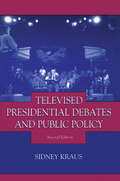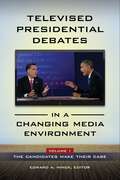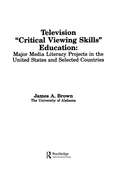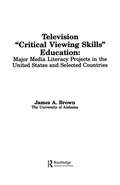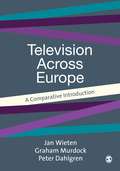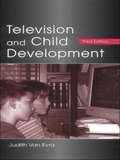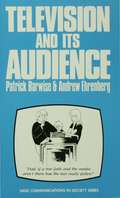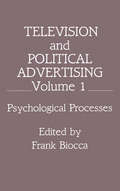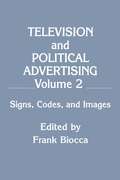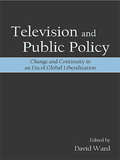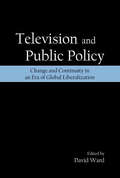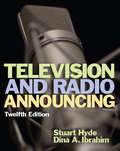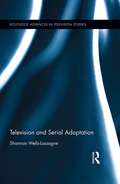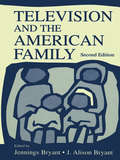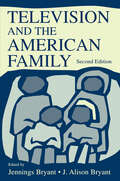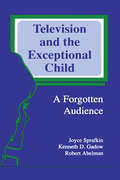- Table View
- List View
Televised Presidential Debates and Public Policy (Communication and Society)
by Sidney KrausWith this second edition, Kraus continues his examination of formal presidential debates, considering the experience of television in presidential elections, reviewing what has been learned about televised debates, and evaluating that knowledge in the context of the election process, specifically, and the political process, generally. He also examines the media and the role they occupy in presidential elections. Because critics often refer to the Lincoln-Douglas debates when reproaching presidential debates, comparisons of the two are discussed throughout the book. Much of the data and information for this accounting of televised presidential debates comes from the author's first-hand experience as one who was involved with these debates as a participant observer, on site at nearly all of the debates discussed. Throughout these discussions, emphasis is placed on the implications for public policy. To suggest policy that will be accepted and adopted by politicians and the public is, at best, difficult. Proposals for changes in public policy based on experience -- even when scientific data support those changes -- must be subjected to an assessment of the values and predispositions of the proponent. These values and predispositions, however, may not necessarily inhibit the proponent's objectivity. As such, this review of television use in the presidential election process provides the context for examining televised debates.
Televised Presidential Debates and Public Policy: Televised Presidential Debates And Public Policy (Communication and Society)
by Sidney KrausWith this second edition, Kraus continues his examination of formal presidential debates, considering the experience of television in presidential elections, reviewing what has been learned about televised debates, and evaluating that knowledge in the context of the election process, specifically, and the political process, generally. He also examines the media and the role they occupy in presidential elections. Because critics often refer to the Lincoln-Douglas debates when reproaching presidential debates, comparisons of the two are discussed throughout the book. Much of the data and information for this accounting of televised presidential debates comes from the author's first-hand experience as one who was involved with these debates as a participant observer, on site at nearly all of the debates discussed. Throughout these discussions, emphasis is placed on the implications for public policy. To suggest policy that will be accepted and adopted by politicians and the public is, at best, difficult. Proposals for changes in public policy based on experience -- even when scientific data support those changes -- must be subjected to an assessment of the values and predispositions of the proponent. These values and predispositions, however, may not necessarily inhibit the proponent's objectivity. As such, this review of television use in the presidential election process provides the context for examining televised debates.
Televised Presidential Debates in a Changing Media Environment [2 volumes]: [2 volumes]
by Edward A. HinckThis two-volume set examines recent presidential and vice presidential debates, addresses how citizens make sense of these events in new media, and considers whether the evolution of these forms of consumption is healthy for future presidential campaigns—and for democracy.The presidential debates of 2016 underscored how television highlights candidates' and campaigns' messages, which provide fodder for citizens' widespread use of new media to "talk back" to campaigns and other citizens. Social media will continue to affect the way that campaign events like presidential debates are consumed by audiences and how they shape campaign outcomes. This two-volume study is one of the first to examine the relationship between debates as televised events and events consumed by citizens through social media. It also assesses the town hall debate format from 1992 to 2016, uses the lens of civil dialogue to consider how citizens watch the debates, and considers the growing impact of new media commentary on candidate images that emerge in presidential and vice presidential debates.Televised Presidential Debates in a Changing Media Environment features contributions from leading political communication scholars that illuminate how presidential debates are transforming from events that are privately contemplated by citizens, to events that are increasingly viewed and discussed by citizens through social media. The first volume focuses on traditional studies of debates as televised campaign events, and the second volume examines the changing audiences for debates as they become consumed and discussed by viewers outside the traditional channels of newspapers, cable news channels, and campaign messaging. Readers will contemplate questions of new forms, problems, and possibilities of political engagement that are resulting from citizens producing and consuming political messages in new media.
Televised Presidential Debates in a Changing Media Environment [2 volumes]: [2 volumes]
This two-volume set examines recent presidential and vice presidential debates, addresses how citizens make sense of these events in new media, and considers whether the evolution of these forms of consumption is healthy for future presidential campaigns—and for democracy.The presidential debates of 2016 underscored how television highlights candidates' and campaigns' messages, which provide fodder for citizens' widespread use of new media to "talk back" to campaigns and other citizens. Social media will continue to affect the way that campaign events like presidential debates are consumed by audiences and how they shape campaign outcomes. This two-volume study is one of the first to examine the relationship between debates as televised events and events consumed by citizens through social media. It also assesses the town hall debate format from 1992 to 2016, uses the lens of civil dialogue to consider how citizens watch the debates, and considers the growing impact of new media commentary on candidate images that emerge in presidential and vice presidential debates.Televised Presidential Debates in a Changing Media Environment features contributions from leading political communication scholars that illuminate how presidential debates are transforming from events that are privately contemplated by citizens, to events that are increasingly viewed and discussed by citizens through social media. The first volume focuses on traditional studies of debates as televised campaign events, and the second volume examines the changing audiences for debates as they become consumed and discussed by viewers outside the traditional channels of newspapers, cable news channels, and campaign messaging. Readers will contemplate questions of new forms, problems, and possibilities of political engagement that are resulting from citizens producing and consuming political messages in new media.
Television ',Critical Viewing Skills', Education: Major Media Literacy Projects in the United States and Selected Countries (Routledge Communication Series)
by James A. BrownRepresenting a significant survey and evaluation of major media literacy projects in the U.S. and selected countries throughout the world, this book covers all aspects of critical viewing skills. It provides comprehensive, theoretical and historical background about the field, the criteria for its evaluation, and various structured programs including the CVS projects and programs sponsored by school districts, individuals, non-governmental national organizations, and private companies. The book can serve as a guide for curriculum planners as well as teachers in the classroom and adult workshops -- and also parents and individual adult viewers -- in applying the best match of theories, practices, readings, and specific exercises to monitor and enhance television's role.
Television ',Critical Viewing Skills', Education: Major Media Literacy Projects in the United States and Selected Countries (Routledge Communication Series)
by James A. BrownRepresenting a significant survey and evaluation of major media literacy projects in the U.S. and selected countries throughout the world, this book covers all aspects of critical viewing skills. It provides comprehensive, theoretical and historical background about the field, the criteria for its evaluation, and various structured programs including the CVS projects and programs sponsored by school districts, individuals, non-governmental national organizations, and private companies. The book can serve as a guide for curriculum planners as well as teachers in the classroom and adult workshops -- and also parents and individual adult viewers -- in applying the best match of theories, practices, readings, and specific exercises to monitor and enhance television's role.
Television Across Europe: A Comparative Introduction (PDF)
by Dr Jan Wieten Peter Dahlgren Professor Graham MurdockCombining institutional textual and audience analysis, this book introduces students to the factors which have shaped television's development in contemporary Europe, and invites them to assess the issues that are at stake in its future. Divided into three parts, the book moves from the European broadcasting environment, through current patterns and trends in programming and programme making, to TV genres and issue-specific broadcasting. Incorporating a range of pedagogical devices: boxes of key facts, activities and notes for further reading, Television across Europe offers an essential introductory guide to television in Western Europe.
Television and Child Development
by Judith Van EvraTelevision continues to play a major role in the lives of most children and adolescents, but current research also reflects the explosive growth in new technologies and their widespread use by young people. Integrating information from communication literature as well as from child development and other psychological domains, author Judith Van Evra presents a summary and synthesis of what is currently known about the media's impact on children's physical, cognitive, social, and emotional development, to help discern the complex and significant interplay between other forces in a child's life and the use of various media. This third edition contains updated and expanded coverage of research findings and a review of changing trends in media use including computers, the Internet, books and magazines, music videos, and video games as well as television. New chapters focus on basic research designs and methodologies; cultural diversity; health-related matters and lifestyle choices; media's impact on various social-emotional aspects of a child's development; the use of technology for information and for entertainment; and intervention possibilities, parent strategies, and education. An overall conclusions section at the end of the book provides a cogent summary of findings to date and stimulates discussion of questions and ideas for future research. Television and Child Development explores how, and to what extent, television and other media actually affect children, and what role other variables may play in mediating their impact, so that we can maximize technology's potential for enriching children's cognitive, social, and emotional development, while at the same time minimizing any negative influence. This text is appropriate for researchers, teachers, and students in communications, developmental and social psychology, and education, as well as in areas of advertising, leisure studies, family studies, and health promotion.
Television and Child Development
by Judith Van EvraTelevision continues to play a major role in the lives of most children and adolescents, but current research also reflects the explosive growth in new technologies and their widespread use by young people. Integrating information from communication literature as well as from child development and other psychological domains, author Judith Van Evra presents a summary and synthesis of what is currently known about the media's impact on children's physical, cognitive, social, and emotional development, to help discern the complex and significant interplay between other forces in a child's life and the use of various media. This third edition contains updated and expanded coverage of research findings and a review of changing trends in media use including computers, the Internet, books and magazines, music videos, and video games as well as television. New chapters focus on basic research designs and methodologies; cultural diversity; health-related matters and lifestyle choices; media's impact on various social-emotional aspects of a child's development; the use of technology for information and for entertainment; and intervention possibilities, parent strategies, and education. An overall conclusions section at the end of the book provides a cogent summary of findings to date and stimulates discussion of questions and ideas for future research. Television and Child Development explores how, and to what extent, television and other media actually affect children, and what role other variables may play in mediating their impact, so that we can maximize technology's potential for enriching children's cognitive, social, and emotional development, while at the same time minimizing any negative influence. This text is appropriate for researchers, teachers, and students in communications, developmental and social psychology, and education, as well as in areas of advertising, leisure studies, family studies, and health promotion.
Television and Its Audience
by Professor Andrew Ehrenberg Professor Patrick BarwiseThis book by two leading experts takes a fresh look at the nature of television, starting from an audience perspective. It draws on over twenty years of research about the audience in the United States and Britain and about the many ways in which television is funded and organized around the world. The overall picture which emerges is of: a medium which is watched for several hours a day but usually at only a low level of involvement; an audience which views mainly for relaxation but which actively chooses favourite programmes; a flowering of new channels but with no fundamental change in what or how people watch; programmes costing millions to produce but only a few pennies to view; a wide range of programme types apparently similar to the range of print media but with nothing like the same degree of audience 'segmentation'; a global communication medium of dazzling scale, speed, and impact but which is slow at conveying complex information and perhaps less powerful than generally assumed. The book is packed with information and insights yet is highly readable. It is unique in relating so many of the issues raised by television to how we watch it. There is also a highly regarded appendix on advertising, as well as technical notes, a glossary, and references for further reading.
Television and Political Advertising: Volume I: Psychological Processes (Routledge Communication Series)
by Frank BioccaThis volume represents one of the first major scholarly effort to unravel the psychological and symbolic processing of political advertising. Utilizing survey, experimental, qualitative, and semiotic methodologies to study this phenomenon, the contributors to Television and Political Advertising trace how political ads help to interpret the psychological reality of the presidential campaign in the minds of millions of voters. A product of the National Political Advertising Research Project, this interdisciplinary effort is valuable to researchers in advertising, communication, and consumer psychology since it helps define future work on the relationship between television, politics, and the mind of the voter. This volume, Television and Political Advertising: Psychological Processes, is the first of two, and covers such topics as Models and Theories for Viewing Political Television; Psychological Processing of Issues, Images, and Form; Differential Processing of Positive and Negative Advertising; and The Psychological Contexts of Processing.
Television and Political Advertising: Volume I: Psychological Processes (Routledge Communication Series)
by Frank BioccaThis volume represents one of the first major scholarly effort to unravel the psychological and symbolic processing of political advertising. Utilizing survey, experimental, qualitative, and semiotic methodologies to study this phenomenon, the contributors to Television and Political Advertising trace how political ads help to interpret the psychological reality of the presidential campaign in the minds of millions of voters. A product of the National Political Advertising Research Project, this interdisciplinary effort is valuable to researchers in advertising, communication, and consumer psychology since it helps define future work on the relationship between television, politics, and the mind of the voter. This volume, Television and Political Advertising: Psychological Processes, is the first of two, and covers such topics as Models and Theories for Viewing Political Television; Psychological Processing of Issues, Images, and Form; Differential Processing of Positive and Negative Advertising; and The Psychological Contexts of Processing.
Television and Political Advertising: Volume Ii: Signs, Codes, and Images (Routledge Communication Series)
by Frank BioccaThis volume represents one of the first major scholarly efforts to unravel the psychological and symbolic processing of political advertising. Utilizing survey, experimental, qualitative, and semiotic methodologies to study this phenomenon, the contributors to Television and Political Advertising trace how political ads help to interpret the psychological reality of the presidential campaign in the minds of millions of voters. A product of the National Political Advertising Research Project, this interdisciplinary effort is valuable to researchers in advertising, communication, and consumer psychology since it helps define future work on the relationship between television, politics, and the mind of the voter. This volume, Television and Political Advertising: Signs, Codes and Images, is the second of two, and covers such areas as Generating Meaning in the Pursuit of Power, Analyses of the Meaning of Political Ads, The Campaign Documentary as an Ad, and Regulating Signs and Images.
Television and Political Advertising: Volume Ii: Signs, Codes, and Images (Routledge Communication Series)
by Frank BioccaThis volume represents one of the first major scholarly efforts to unravel the psychological and symbolic processing of political advertising. Utilizing survey, experimental, qualitative, and semiotic methodologies to study this phenomenon, the contributors to Television and Political Advertising trace how political ads help to interpret the psychological reality of the presidential campaign in the minds of millions of voters. A product of the National Political Advertising Research Project, this interdisciplinary effort is valuable to researchers in advertising, communication, and consumer psychology since it helps define future work on the relationship between television, politics, and the mind of the voter. This volume, Television and Political Advertising: Signs, Codes and Images, is the second of two, and covers such areas as Generating Meaning in the Pursuit of Power, Analyses of the Meaning of Political Ads, The Campaign Documentary as an Ad, and Regulating Signs and Images.
Television and Precarity: Naturalist Narratives of Poor America
by Jasmin HumburgJasmin Humburg provides evidence of naturalist narrative strategies, tropes, and character variations in six contemporary American television series: The Wire, Tremé, Shameless, Ozark, Orange is the New Black and 2 Broke Girls. The author investigates how poverty is negotiated through classic literary naturalism and contemporary televisual articulations, and how the latter may have been influenced by the former in the age of the Great Recession. By connecting literary studies, television studies, and concepts of social mobility, this project contributes to the field of new poverty studies.
Television and Public Policy: Change and Continuity in an Era of Global Liberalization
by David WardThe significant changes that have swept the television industry over the last two decades, most notably a shift to deregulation in broadcast media, prompt a discussion on how to ensure that meaningful content is available to the viewer. Television and Public Policy analyzes the current state of television systems in a selected group of countries by exploring the political, economic, and technological factors that have shaped the sector in such a short span of time. Consequently, by positioning the television sector within issues of media policy and the regulatory framework, the book questions what these trends mean for television, and the historical, political, and cultural role in our societies. Television and Public Policy distinguishes itself in several ways:*It is a global project in its comparative scope and subject area. Contributors represent countries including Australia, Brazil, Canada, China, Egypt, India, Iran, Ireland, Israel, Italy, Japan, the Netherlands, New Zealand, Poland, the United Kingdom, and the United States.*It is contemporary and filled with information largely absent in current literature.*It offers original analysis of the contemporary television sector. This book speaks to a broad range of academics, postgraduate, and undergraduate students, and can serve as a key resource for courses ranging from media studies, to development studies, international relations, and law.
Television and Public Policy: Change and Continuity in an Era of Global Liberalization
by David WardThe significant changes that have swept the television industry over the last two decades, most notably a shift to deregulation in broadcast media, prompt a discussion on how to ensure that meaningful content is available to the viewer. Television and Public Policy analyzes the current state of television systems in a selected group of countries by exploring the political, economic, and technological factors that have shaped the sector in such a short span of time. Consequently, by positioning the television sector within issues of media policy and the regulatory framework, the book questions what these trends mean for television, and the historical, political, and cultural role in our societies. Television and Public Policy distinguishes itself in several ways:*It is a global project in its comparative scope and subject area. Contributors represent countries including Australia, Brazil, Canada, China, Egypt, India, Iran, Ireland, Israel, Italy, Japan, the Netherlands, New Zealand, Poland, the United Kingdom, and the United States.*It is contemporary and filled with information largely absent in current literature.*It offers original analysis of the contemporary television sector. This book speaks to a broad range of academics, postgraduate, and undergraduate students, and can serve as a key resource for courses ranging from media studies, to development studies, international relations, and law.
Television and Radio Announcing
by Stuart HydeThe digital revolution has significantly changed broadcast technology. The 12th edition of Television and Radio Announcing reflects new trends in the field, such as the reconfiguration of electronic media production practices and distribution models. The internet and social media have opened up new access to production and new methods of distribution, such as YouTube, Facebook, Twitter, and podcasts. The 12th edition addresses the realities of students who live in this new era. Learning GoalsUpon completing this book, readers will be able to: Develop essential announcing skills Understand new trends in the field
Television and Radio Announcing: Text With Audio Cd
by Stuart HydeThe digital revolution has significantly changed broadcast technology. The 12th edition of Television and Radio Announcing reflects new trends in the field, such as the reconfiguration of electronic media production practices and distribution models. The internet and social media have opened up new access to production and new methods of distribution, such as YouTube, Facebook, Twitter, and podcasts. The 12th edition addresses the realities of students who live in this new era. Learning GoalsUpon completing this book, readers will be able to: Develop essential announcing skills Understand new trends in the field
Television and Serial Adaptation (Routledge Advances in Television Studies)
by Shannon Wells-LassagneAs American television continues to garner considerable esteem, rivalling the seventh art in its "cinematic" aesthetics and the complexity of its narratives, one aspect of its development has been relatively unexamined. While film has long acknowledged its tendency to adapt, an ability that contributed to its status as narrative art (capable of translating canonical texts onto the screen), television adaptations have seemingly been relegated to the miniseries or classic serial. From remakes and reboots to transmedia storytelling, loose adaptations or adaptations which last but a single episode, the recycling of pre-existing narrative is a practice that is just as common in television as in film, and this text seeks to rectify that oversight, examining series from M*A*S*H to Game of Thrones, Pride and Prejudice to Castle.
Television and Serial Adaptation (Routledge Advances in Television Studies)
by Shannon Wells-LassagneAs American television continues to garner considerable esteem, rivalling the seventh art in its "cinematic" aesthetics and the complexity of its narratives, one aspect of its development has been relatively unexamined. While film has long acknowledged its tendency to adapt, an ability that contributed to its status as narrative art (capable of translating canonical texts onto the screen), television adaptations have seemingly been relegated to the miniseries or classic serial. From remakes and reboots to transmedia storytelling, loose adaptations or adaptations which last but a single episode, the recycling of pre-existing narrative is a practice that is just as common in television as in film, and this text seeks to rectify that oversight, examining series from M*A*S*H to Game of Thrones, Pride and Prejudice to Castle.
Television and the American Family
by J. Alison BryantThis second edition of a trend-setting volume provides an updated examination of the interaction between families and the most pervasive mass medium: television. Charting the dynamic developments of the American family and television over the past decade, this volume provides a comprehensive representation of programmatic research into family and television and examines extensively the uses families make of television, how extensions of television affect usage, families' evolving attitudes toward television, the ways families have been and are portrayed on television, the effects television has on families, and the ways in which families can mediate its impact on their lives. The volume is an invaluable resource for scholars and students in the areas of media and society, children and media, and family studies.
Television and the American Family
by J. Alison BryantThis second edition of a trend-setting volume provides an updated examination of the interaction between families and the most pervasive mass medium: television. Charting the dynamic developments of the American family and television over the past decade, this volume provides a comprehensive representation of programmatic research into family and television and examines extensively the uses families make of television, how extensions of television affect usage, families' evolving attitudes toward television, the ways families have been and are portrayed on television, the effects television has on families, and the ways in which families can mediate its impact on their lives. The volume is an invaluable resource for scholars and students in the areas of media and society, children and media, and family studies.
Television and the Exceptional Child: A Forgotten Audience (Routledge Communication Series)
by Joyce Sprafkin Kenneth D. Gadow Robert AbelmanThe question of what types of children are most influenced by -- or can best benefit from -- television is a recurrent theme in the scientific literature as well as a frequently raised issue for pediatric associations, educators, and parent/citizen groups concerned about the welfare and advancement of young children. To effectively address this question, this book focuses on a wide variety of children with highly divergent cognitive abilities, social skills, and educational capacities -- that is, those labeled as emotionally disturbed, learning disabled, mentally retarded, and intellectually gifted. These children not only possess characteristics that place them at the greatest risk with regard to television's negative impact, but also in a position to most benefit from the purposeful use of the medium at home and in the classroom. Combining literature from the fields of mass communication, developmental psychology, and special education, the authors present a comprehensive analysis of television and its "forgotten audience." Practical implications and applications in the home and school are also extracted from research findings making this volume a valuable resource for students, educators, and researchers in the fields of communication and special education, and for the parents and teachers of exceptional children.
Television and the Exceptional Child: A Forgotten Audience (Routledge Communication Series)
by Joyce Sprafkin Kenneth D. Gadow Robert AbelmanThe question of what types of children are most influenced by -- or can best benefit from -- television is a recurrent theme in the scientific literature as well as a frequently raised issue for pediatric associations, educators, and parent/citizen groups concerned about the welfare and advancement of young children. To effectively address this question, this book focuses on a wide variety of children with highly divergent cognitive abilities, social skills, and educational capacities -- that is, those labeled as emotionally disturbed, learning disabled, mentally retarded, and intellectually gifted. These children not only possess characteristics that place them at the greatest risk with regard to television's negative impact, but also in a position to most benefit from the purposeful use of the medium at home and in the classroom. Combining literature from the fields of mass communication, developmental psychology, and special education, the authors present a comprehensive analysis of television and its "forgotten audience." Practical implications and applications in the home and school are also extracted from research findings making this volume a valuable resource for students, educators, and researchers in the fields of communication and special education, and for the parents and teachers of exceptional children.
